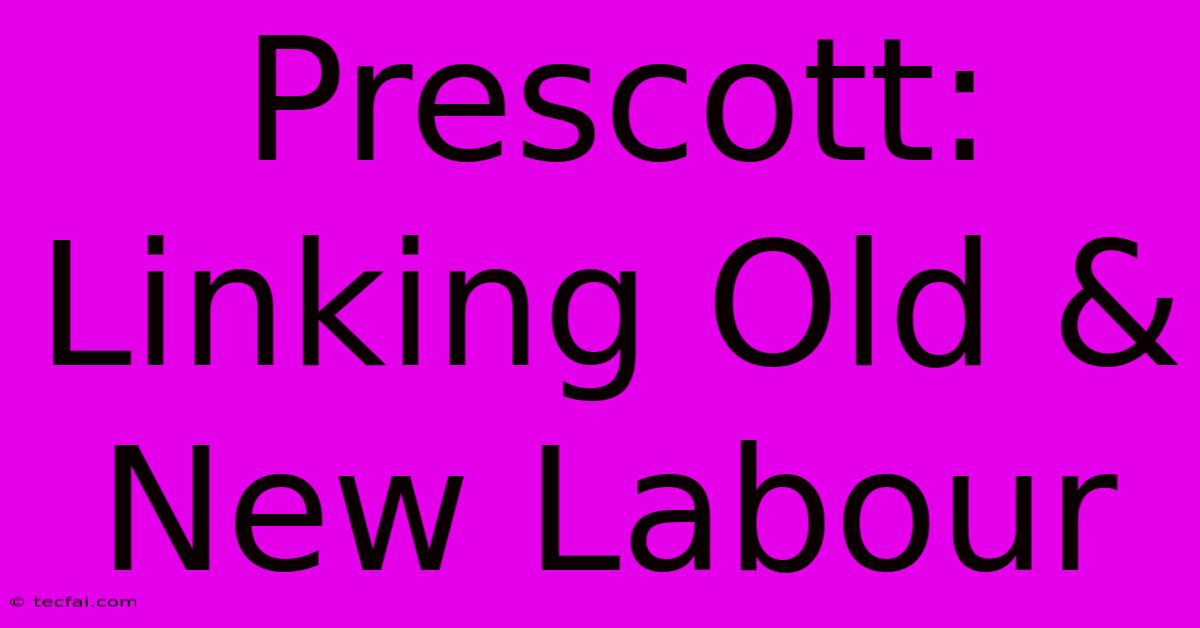Prescott: Linking Old & New Labour

Discover more detailed and exciting information on our website. Click the link below to start your adventure: Visit Best Website tecfai.com. Don't miss out!
Table of Contents
Prescott: Linking Old & New Labour
John Prescott, a prominent figure in the British Labour Party, stands as a fascinating bridge between the "Old Labour" of the post-war era and the "New Labour" project of Tony Blair. His career, spanning decades, reflects the evolution of the party itself, highlighting both continuities and dramatic shifts in ideology and strategy. Understanding Prescott's role is key to understanding the complexities of Labour's transformation in late 20th and early 21st-century Britain.
From Hull to Westminster: The Roots of Old Labour
Prescott's early career was firmly rooted in the traditional working-class Labour movement. Born and raised in Hull, a city with a strong industrial heritage, he experienced firsthand the realities of working-class life and the struggles of trade unionism. This background shaped his political beliefs, instilling in him a deep commitment to social justice and economic equality – core tenets of Old Labour. His early political activism, often characterized by robust rhetoric and a no-nonsense approach, reflected this deeply ingrained sense of working-class solidarity. He was a quintessential representative of the party's traditional base, deeply connected to the concerns of ordinary people.
The Deputy Prime Minister: Navigating New Labour's Terrain
Prescott's appointment as Deputy Prime Minister under Tony Blair marked a pivotal moment, showcasing the uneasy alliance between Old and New Labour. While Blair spearheaded the party's modernization, embracing a "third way" that sought to reconcile social justice with economic pragmatism, Prescott, with his more traditional working-class roots, provided a crucial link to the party's past. His role was arguably one of balancing the party's radical roots with its newfound ambition for power under Blair's leadership. This duality often led to public clashes and contrasting policy approaches, yet it maintained a degree of internal party cohesion. He championed many traditional Labour causes, acting as a voice of caution against excessive privatization and ensuring that social issues remained central to the government's agenda.
Policy Impacts and Legacy
Prescott's influence extended to various significant policy areas. His focus on regeneration, particularly in urban areas, reflected his commitment to addressing social inequalities. Initiatives aimed at improving infrastructure and creating jobs in deprived communities showcased a blend of Old Labour's commitment to social welfare and New Labour's focus on economic dynamism. While the success of these projects remains a subject of debate, they underscore Prescott's enduring dedication to improving the lives of working-class Britons. His legacy is also intertwined with controversies, including those related to his personal conduct, which served to highlight the tensions inherent in reconciling the traditional and modernized aspects of the Labour Party.
Bridging the Gap: A Complex Legacy
John Prescott's career offers a nuanced perspective on the transition from Old to New Labour. He represented a vital bridge, connecting the party's traditional working-class base with its revised, more centrist platform. His influence, although sometimes contentious, played a significant role in shaping Labour's policies and agenda during a period of substantial political transformation. Analyzing his legacy requires careful consideration of both his policy successes and the inherent contradictions and controversies that characterized his time in office. This complex legacy continues to shape discussions around the future of the Labour Party and its relationship with its historical identity.
Keywords: John Prescott, Old Labour, New Labour, Tony Blair, British Labour Party, Deputy Prime Minister, Working Class, Social Justice, Economic Equality, Policy, Regeneration, Political Transformation, Third Way.

Thank you for visiting our website wich cover about Prescott: Linking Old & New Labour. We hope the information provided has been useful to you. Feel free to contact us if you have any questions or need further assistance. See you next time and dont miss to bookmark.
Featured Posts
-
Bosa Purdy Injury Update Week 12 Game
Nov 23, 2024
-
Trumps Agriculture Secretary Pick
Nov 23, 2024
-
Two Released After Gatwick Airport Detention
Nov 23, 2024
-
Mc Gregor Civil Trial Sexual Assault Verdict
Nov 23, 2024
-
France Vs Argentina On Tv Tonight
Nov 23, 2024
